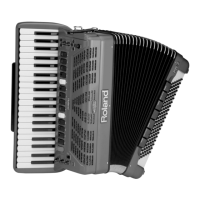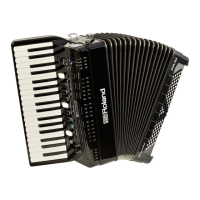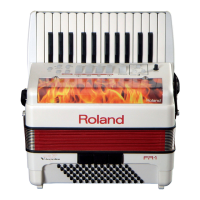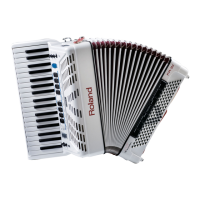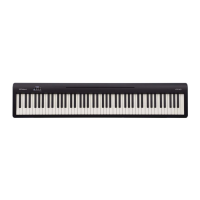Selecting Parameters
73
2.5 MFX Control
Select this page to assign a control to the MFX.
Parameter Value Explanation
Control 1 Source O, EFX Pot, Aftert
Select “EFX Pot” to control
the MFX by “EFFECT”
potentiometer.
Select “After” to control the
MFX by aftertouch.
NOTE
The treble keyboard
of the piano-type
model also generates
aftertouch messages
(on the button- type
model, aftertouch can
be generated with the
Master bar). “Aftertouch”
refers to the fact that
you press a key even
further down after
playing a note.
Control 1 Sens -63~0~+63 Adjust the sensitivity.
Control 1 Assign
The eects to assign depend on the MFX type that
you selected. See “2.3 Eects Send” (p. 72).
Control 2 Source As “Control 1 Source”
Control 2 Sens As “Control 1 Sens”
Control 2 Assign As “Control 1 Assign”
Control 3 Source As “Control 1 Source”
Control 3 Sens As “Control 1 Sens”
Control 3 Assign As “Control 1 Assign”
Control 4 Source As “Control 1 Source”
Control 4 Sens As “Control 1 Sens”
Control 4 Assign As “Control 1 Assign”
2.6 Controllers
In this page you can control the release of sound,
the bellows detune and the after touch pitch.
Parameter Value Explanation
RELEASE –64~0~63
This parameter that allows you to
shorten the right hand accordion
sounds if you feel the virtual reeds
linger a bit long after you release
a key. To do so, select a negative
value.
The term “Release” is taken from
synthesizers and refers to the
speed at which the notes you play
disappear when you release the
keys.
Parameter Value Explanation
BELLOWS DETUNE
O, Low,
Standard, High
This parameter further adds
to the realism of the sounds
emulated by your FR-8x. Here, you
can specify how strongly the pitch
of the simulated Treble reed(s)
changes when you open or close
the bellows faster than usual.
If the “Standard” setting seems
too mild, try “High”. If it is too
strong, use “Low”. If you don’t
want any detuning eect, select
“O”. The most convincing setting
usually depends on the selected
instrument(s). See “2.1 Reed Type”
(p. 71).
AFTERTOUCH
PITCH
O, 1/4 Down,
1/2 Down, 1/4
Up, 1/2 Up
As stated earlier, the right hand
keyboard of the piano-type model
also generates aftertouch mes-
sages (on the button- type model,
aftertouch can be generated with
the Master bar). “Aftertouch” refers
to the fact that you press a key
even further down after playing
a note. This eect allows you to
bend the pitch down (temporarily
lower the note) by a quarter tone
(“1/4 Down”) or a semi-tone (“1/2
Down”). Select “1/4 Up” or “1/2 Up”
to bend the notes up a quarter or
a semi-tone.
Select “O” to switch o the treble
section’s aftertouch recognition.
NOTE
This aftertouch eect applies
to all notes that are sounding
simultaneously. If you play
a chord and then only press
down one key of the chord’s
constituent notes even further,
all notes are bent by the same
amount.
2.7 MIDI TX
This page contains a series of MIDI parameters for
the selected register. You need to set them one by
one. These parameters are saved along with all
other Set parameters, which allows you to use
dierent MIDI settings for each Set – and even
each register within a Set.
Parameter Value Explanation
Note Tx
On, O
Default: On
Set this parameter to “O” if the external
instrument must not double the notes you
are playing on the right hand (Accordion
section).
Octave
–3~0~+3
Default: 0
This parameter allows you to transpose
the Note-on messages transmitted by the
accordion section (if “Note” is set to “On”) up
to three octaves up or down.
Each MIDI note has a unique number. This
parameter allows you to add (or subtract) 12
(“1” octave), 24 (“2” octaves) or 36 (“3” octaves)
to (from) the note numbers generated by
your playing.

